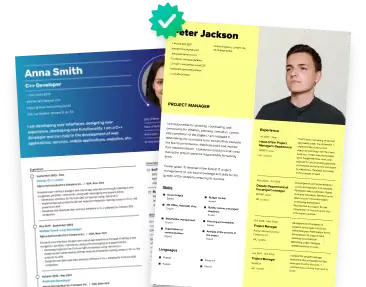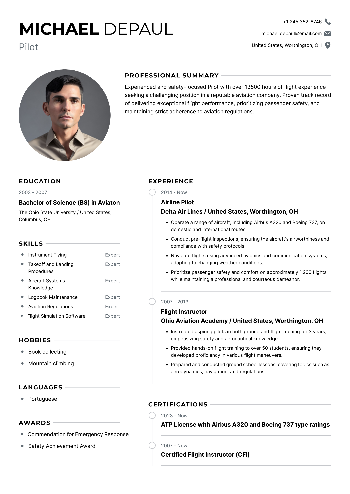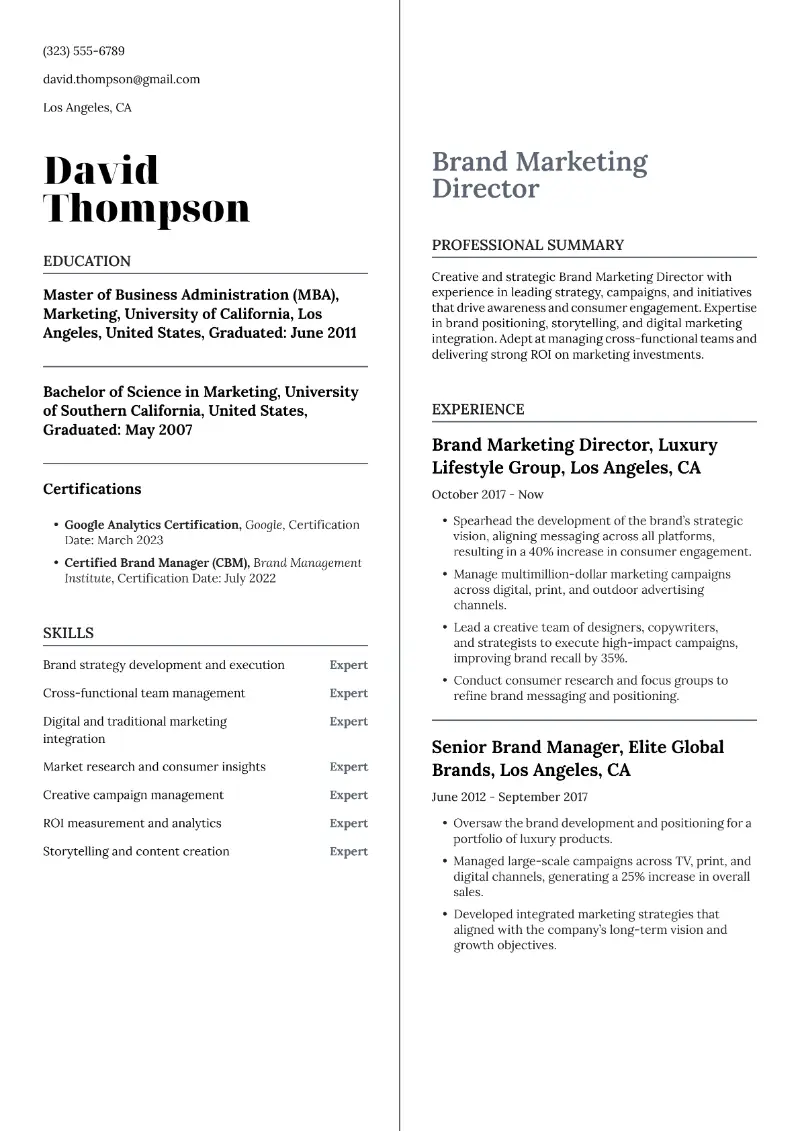In today’s competitive job market, having an outstanding resume is crucial to landing your dream position. It's your first impression, so it needs to quickly highlight your skills, achievements, and experience.
With recruiters spending just seconds reviewing each application, how to make your resume stand out and ensure it captures their attention?
In this guide, we’ll explore effective strategies to elevate your document, from optimizing the content to designing it for impact. Whether you're entering the job market for the first time or looking to pivot into a new field, these tips will help you be unique in a sea of applicants.
Basics of a resume
All resumes that stand out begin with a solid foundation. Understanding the core components and resume sections that make up a well-crafted document is essential before diving into more advanced strategies.
1. Contact information
At the very top of the page, you should clearly list your name, phone number, email address, and location (city and state). Keep this information up-to-date and easy to find.
While it’s optional, including a link to your professional online profile, such as LinkedIn, can be a great addition.
Additionally, you might want to attach other URLs like your social media accounts (e.g., GitHub for developers, Behance for designers) or a personal website where you showcase your portfolio.
2. Opening statement
A resume summary shows how your background aligns with the job you're applying for.
When to use it:
- You have work experience (at least 2+ years).
- You want to highlight your qualifications, accomplishments, or skills.
- You’re targeting a specific job or field.
Examples of resume opening statement:
Experienced Marketing Specialist with over 5 years of experience in digital marketing, social media strategy, and SEO optimization. Proven track record in increasing web traffic by 30% year-over-year and managing marketing budgets over $100K. Adept at developing creative campaigns, driving brand awareness, and improving customer engagement.
Dedicated customer service professional with experience delivering excellent support through phone, email, and live chat. Skilled in resolving customer issues, providing product recommendations, and maintaining high levels of customer satisfaction.
Results-driven product manager with over 4 years of experience leading cross-functional teams to launch innovative products. Expertise in user-centered design, product lifecycle management, and data analysis. Proven track record of managing product roadmaps and executing strategies that lead to measurable business growth.
A resume objective is more focused on what you want to achieve in the role.
When to pick it:
- You’re just starting your career or have minimal experience.
- You’re changing industries and want to explain the transition.
- You want to underline your work goals in relation to the occupation.
Examples of resume objective:
Motivated recent graduate with a degree in Computer Science, seeking an entry-level software engineering role at a leading tech company. Eager to apply coding skills in Java and Python, and contribute to innovative projects that support business goals and growth.
Passionate marketing graduate looking for a beginner position in digital marketing where I can apply my mastery in social media, content creation, and search engine optimization to help grow and promote a brand.
Dedicated and empathetic HR professional aiming to employ my skills in recruitment and employee development to contribute to a positive work environment.
3. Skills
Many firms use Applicant Tracking Systems (ATS) to filter resumes. These scan for keywords related to the job description. By incorporating relevant abilities, you increase the chances of your paper passing the screening.
- Hard skills include technical knowledge or expertise, such as proficiency in software, languages, or industry-specific knowledge.
- Soft skills are interpersonal qualities like communication, leadership, or problem-solving.
Hard skills for resume examples:
- Data Analysis
- Project Management
- Web Development
- SQL Database Management
- Graphic Design (Adobe Suite)
- Technical Writing
- Machine Learning
- Cloud Computing (AWS, Azure)
- Cybersecurity
- Data Visualization (Tableau, PowerBI)
- UI/UX Design
- Database Administration
- Automation (Selenium, Jenkins)
- Business Intelligence (Power BI, Qlik)
- Network Administration
- Video Editing (Premiere Pro, Final Cut Pro)
Soft skills for resume examples:
- Communication
- Teamwork
- Problem-Solving
- Adaptability
- Leadership
- Time Management
- Critical Thinking
- Emotional Intelligence
- Conflict Resolution
- Creativity
- Decision-Making
- Collaboration
- Interpersonal Skills
- Multitasking
- Attention to Detail
- Negotiation
- Customer Service
4. Work experience
This is arguably the most important section of your resume. It’s where you’ll place your professional history, starting with the most recent role.
For each entry, include:
- Job title
- Company name
- Location (city and state)
- Dates of employment
- A bullet-point list of your responsibilities and achievements
Example of experience on a resume:
Software Engineer
Tech Innovations Inc. – San Francisco, CA
January 2023 – October 2025
- Developed and maintained web applications using JavaScript and React, improving user experience and functionality.
- Collaborated with cross-functional teams to design and implement software solutions that increased product efficiency by 20%.
- Conducted code reviews and mentored junior developers, contributing to a collaborative and growth-oriented team environment.
- Utilized Agile methodologies to ensure timely project delivery and successful sprint completion.
Marketing Coordinator
Elevate Solutions – Boston, MA
June 2021 – December 2022
- Managed digital marketing campaigns, increasing website traffic by 25% through SEO and paid advertising strategies.
- Collaborated with the team to develop targeted marketing materials that supported new product launches.
- Analyzed campaign performance metrics, providing actionable insights for optimizing future marketing efforts.
- Organized and hosted events to engage potential clients, resulting in a 15% increase in lead generation.
5. Education
List your highest level of education, including the degree you earned, the institution, and the year of graduation. If you’ve taken relevant courses or completed certifications, feel free to mention them as well.
Examples of education on a resume:
Bachelor of Science in Computer Science
University of California, Berkeley, CA
Graduated: May 2024
- Relevant Coursework: Data Structures, Algorithms, Software Engineering, Web Development
Bachelor of Arts in Marketing
Boston University, MA
Graduated: May 2023
- Relevant Coursework: Consumer Behavior, Brand Strategy, Marketing Analytics
6. Additional sections (Optional)
Depending on your field or level of experience, you might want to incorporate other blocks. This is what makes a resume stand out.
- Certifications. Any relevant industry certifications.
- Volunteer Work. Demonstrates leadership, community involvement, and soft skills.
- Awards and Honors. Recognitions or achievements.
- Languages. Any foreign languages you speak fluently.
- Publications. Articles, books, or papers you’ve published in your field.
Create your professional Resume in 10 minutes for FREE
Build My Resume
How to make my resume stand out?
One of the most effective ways to make your resume stand out is by customizing it for each specific job you apply for. This shows the employer that you’re genuinely interested and have taken the time to align your experience and skills with the requirements.
Highlight the industry keywords mentioned in the job posting, and make sure these are reflected in your resume. This helps it pass through Applicant Tracking Systems (ATS), which are used by many companies to screen documents.
Instead of simply listing your job duties, focus on your accomplishments and how they contributed to the success of the organization.
Instead of saying you "managed projects," say you "led projects that resulted in a 15% increase in efficiency and reduced costs by 10%."
A clean, professional design is how to make a resume more appealing and easier to read. Hiring managers often skim applications quickly, so make sure yours is easy to navigate.
- Use a standard font like Arial or Calibri in size 10-12 points.
- Make section titles bold or in larger font sizes to break up the content.
- Present information in short, concise bullet points rather than long paragraphs.
- Ensure there’s enough space between blocks and around the margins to prevent the page from looking cluttered.
Your choice of language can make a big difference in how your outstanding resume is perceived.
Use action verbs that showcase your achievements, like:
- Managed
- Developed
- Led
- Created
- Increased
- Optimized
- Coordinated
Examples of resumes that stand out:
Conclusion on how to make your resume stand out
A well-crafted resume is more than just a list of your qualifications—it’s a powerful marketing tool that can open doors to new opportunities.
By focusing on clarity, relevance, and showcasing your unique strengths, you can create a document that grabs attention and gets you noticed.
Remember, standing out isn’t about embellishing your experience but about presenting it in a compelling, clear, and concise way. With these tips in hand, you’re ready to make a lasting impression on any recruiter or hiring manager.
Create your professional Resume in 10 minutes for FREE
Build My Resume









